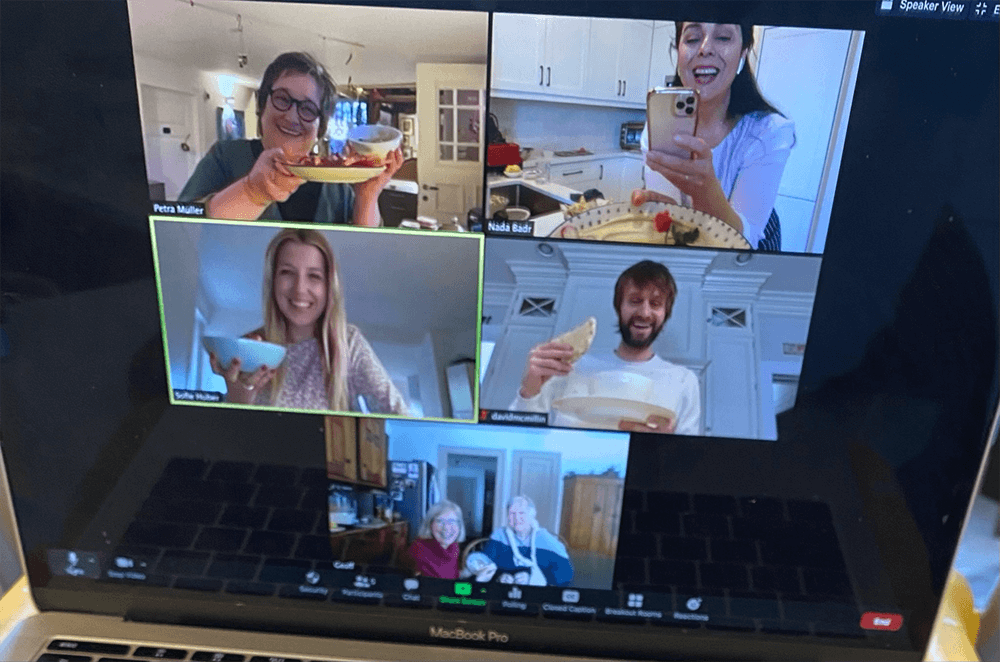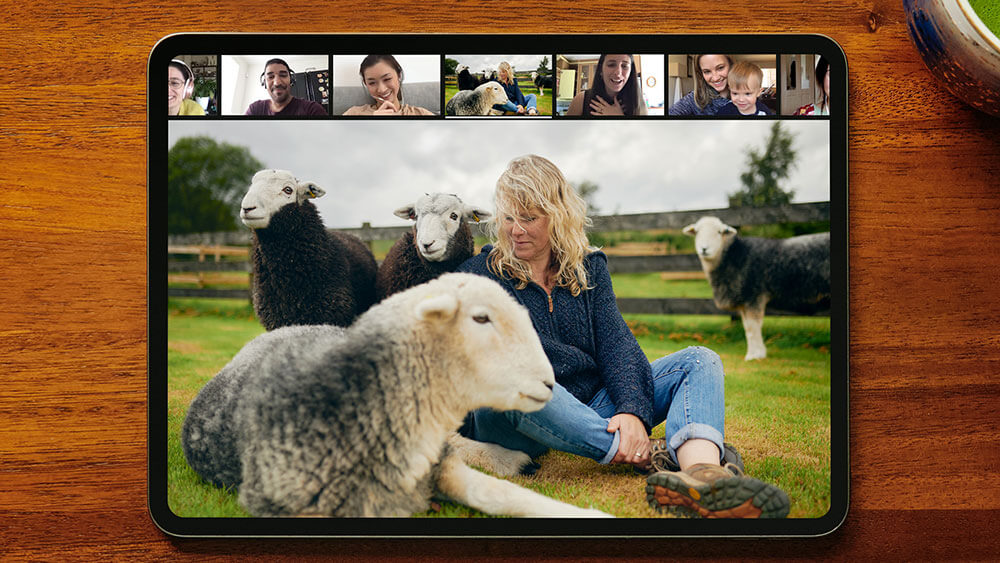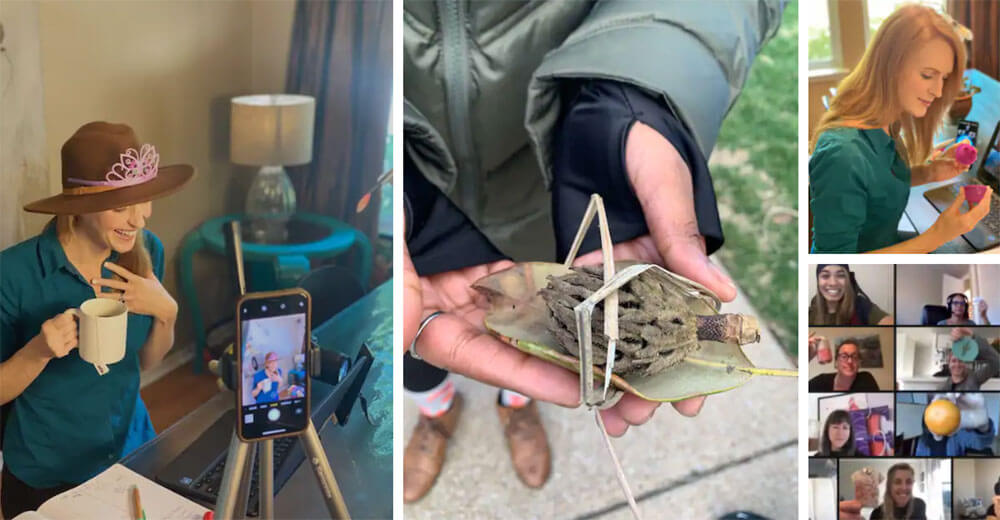
Nada Badr (upper right), a professionally trained Lebanese chef who lives in Toronto, presents one of her hummus-making classes through Airbnb’s Online Experiences.
When the world pressed pause in mid-March 2020, Airbnb’s mantra of “Belong Anywhere” — a nod to the company’s focus on inclusion and its push to democratize travel — was in serious danger. How do you feel like you belong somewhere if you cannot actually go there?
In May, Airbnb laid off approximately one-quarter of its staff, and the future of the sharing economy giant looked as uncertain as the rest of the travel and tourism industry. However, the company saw an opportunity in the digital landscape to leverage certain Airbnb Experiences — a product the company launched in 2017 to give travelers a chance to book sailing lessons, axe-throwing sessions, brewery tours, and more with local guides in the communities where they had rented an Airbnb property — as Online Experiences. By August, there were more than 700 options — ranging from drinking sangria with drag queens to meditating with a Buddhist monk — which succeeded in transporting audiences to a different place. A search of “Great for groups” on the Online Experiences page yields 250 options. In a survey of more than 900 guests last summer, 82 percent indicated that Airbnb’s offerings featured more unique activities than other online experiences they had participated in.
Airbnb’s Online Experiences all happen on the ubiquitous Zoom, so what’s the secret to setting these sessions apart? Three online hosts share their secrets to giving participants a sense of place from their couches and kitchens.
A Recipe With a Story
Google “hummus recipe” and the world’s largest search engine will deliver more than 49 million results. Nada Badr, a professionally trained Lebanese chef who lives in Toronto and has been teaching cooking classes for more than 15 years, acknowledged that “there are millions of recipes for making hummus — and many of them,” Badr, who hosts “Making Hummus with a Lebanese Chef,” told Convene, “are good.”
But there’s a big difference between following a recipe and following an individual’s journey through life. Badr’s tutorial focuses less on ingredients and more on personal stories designed to create a deep connection. “We all connect taste with memory,” Badr said. “So, I share my own memories from growing up in Lebanon, my first introduction to cooking with my mom, and my background with my parents. It is not only the recipe. It is about the experience.”
One ingredient listed in the instructions I received prior to my timeslot for a Saturday morning class — which is available for corporate groups of up to 25 attendees and groups of individuals — was “a sprinkle of love.” As we started cooking and testing our garlic-to-lemon ratios, Badr shared how her mother encouraged her to make her passion for cooking a way to express love, and her stories extended beyond her own personal life to share insights into Lebanese culture, like common serving styles and presentations found throughout the country’s kitchens.
Badr told me that a silver lining in the shift to digital cooking classes has been a chance to share her lessons with a global audience — indeed, in our class we had views of participants’ kitchens in France, Germany, Canada, and the U.S. The real power of Badr’s class, though, came to life when we weren’t looking at the Zoom gallery. Before we raised a pita toast (my hummus was delicious, by the way), she invited us all on a trip.
“Close your eyes,” Badr told our group. “We are going on a trip to Lebanon, and I’m covering all the expenses.” Badr’s imaginary tour of Qabb Illyas, the town where she grew up in eastern Lebanon, painted a mental picture of her family’s immaculate gardens, their dining room, and the table where she ate as a young girl.
“They will welcome you and speak to you in Arabic,” she said. “You will have no idea what they are saying, but you will feel the warmth and welcoming nature that is ingrained in our culture. My mom would always say to dad before he even swallowed his first bite, ‘Taybeh?’ which means, ‘Does it taste good?’” Badr said. “And my dad would smile and say to mom, ‘Sallem dayetik’ which translates to ‘May God bless your hands.’ Basically, he was just saying thank you, but the saying of Sallem dayetik in Arabic is more powerful and has more meaning than a simple thank you.”

The Guided Meditation with Sleepy Sheep experience, from Scotland, features Hamish, Dougal, and Lochie the sheep, as well as host Beccy and her yoga instructor daughter, Rivkah.
A Stroll Through Vegas
Closing your eyes is not a request Jonathan Hernandez makes in his 90-minute exploratory walking tour of the Las Vegas Strip. While face masks, hand sanitizer, and social distancing have been some of the crucial weapons in fighting the pandemic, Hernandez has relied on an additional tool to weather the challenges for his business: a 360 camera.
Hernandez captured 360-degree footage of the famed Strip in an effort to make the online experience feel more captivating than standard video, although he said he wished he could have started before the stay-at-home orders took effect. “Filming the Vegas Strip right now is a little more tame,” Hernandez told Convene. “You don’t get all the crazy characters like you used to.”
Some of those characters that enhance the in-person experience may be missing from the at-home tour, but Hernandez’s mission to showcase the off-the-beaten-path gems of Las Vegas remains the same. “It’s not a traditional tour,” he says. “It feels more like a bunch of friends hanging out, and I aim to introduce all of them to the hidden places that makes Vegas special.” Among them: a restaurant hidden in the back of the Flamingo Hotel, a bar that offers 50-cent beers for happy hour, and the 23rd-floor lounge of the Waldorf Astoria, which Hernandez describes as “one of the best views of the Strip that no one even knows exists.”
The shift to deliver the vibe of Vegas to participants’ living room has meant two big adjustments for Hernandez — less exercise, as the in-person tour is around 12,000 steps, and less sleep, as he works to attract global audiences. “It’s definitely a change in atmosphere,” Hernandez said. “When we’re in person, we can stop at a bar, grab a drink, and meet some of my favorite bartenders.”
The online tour is obviously a BYOB experience, and Hernandez said that plenty of guests do pop up on the screen holding a celebratory beverage to toast. It’s exactly what they would be savoring if they were imbibing underneath the bright lights of the Vegas Strip. “You can walk around with a drink in your hand when you’re here,” Hernandez said. “Even though this is online, I try to make it as much ‘Vegas’ as I can.”

The Living Room Legends Scavenger Hunt — an experience that relies on common household items — is one of the top-selling experiences on Airbnb.
Touch and Feel Austin
For Kat Nelson, a sense of touch is the ticket to awakening one’s understanding of a destination, and she shows how to do it with everyday items in your home. Nelson is the founder of Texas-based Alley Kat Adventures, a company that runs scavenger hunts in more than 30 cities across North America. While all that business was in-person prior to the pandemic, Nelson’s quick shift to online has proven fruitful: The company’s Living Room Legends scavenger hunt — an experience that relies on common household items — is one of the top-selling experiences on Airbnb, with around 85 percent of her business coming from corporate events hosted by companies like Goldman Sachs, Toyota, and Ford.
In addition to those scavenger hunts, Nelson offers an experience that feels closer to home — literally. She lives just north of the Texas state capital, and her “Keep Austin Weird Immersive Experience” gives guests a taste of what makes the city unique. Before the experience begins, guests receive a short checklist of items they need for the hour-long experience.
“People don’t have any idea of why they need these props until they get started,” Nelson said. “Half the fun is gathering them in advance. They could not be more random.”
Once they get started, though, the meaning behind each item becomes clear. For example, part of the Austin experience includes an introduction to the Before I Die Wall — a hidden landmark that includes an ever-changing list of bucket-list goals jotted down by those who stop by.
“The people are the art,” Nelson said. “We’ll show the online guests a picture of how it looks on a particular day.” Then, one of those props — a dry-erase marker — comes in handy. “I’ll ask guests to go write on their mirror or their window one thing they want to do before they die,” Nelson said. “Some people share big goals like skydiving, and others share really touching things they want to accomplish.”
In addition to touching items in their homes, guests access their screens in a competition that feels akin to alternate reality. The experience features 360-degree footage of parts of Austin, including the interior of Nelson’s favorite art gallery, a boot store, and the South Congress neighborhood. The guests compete in teams to identify specific items in the environment. “It’s amazing what adults will do for points,” Nelson said. “We’re all just tall children.”
David McMillin, former Convene associate editor, is a freelance writer based in Chicago.
